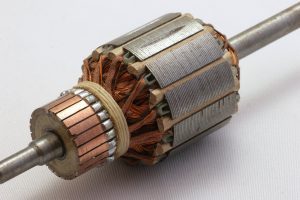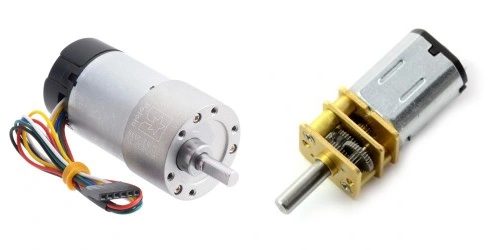Table of Contents:
Which one to choose in power tools?
Any mechanical expert should understand the difference between brush and brushless DC motors. Brush motors were once very common. In fact, they are still nowadays, although they are being largely replaced by their brushless counterparts, The right kind of DC of any type can make a project or home power tool much more efficient.
Brush motor, brushless motor – the difference
Brush motors vel commutator motors
A brush DC motor uses a coil configuration of wound wire, armature, acting as a bipolar electromagnet. Brushes power the rotary commutator part and windings of the rotor. It consists of a cylinder made up of many metal contact segments. Without a commutator, there’s nothing to do!
Your typical DC brush motor consists of:
- a rotor through which the outermost axle passes,
- windings wound around the rotor,
- a stator surrounding the rotor, which contains the magnets,
- a commutator that switches the windings,
- brushes that supply power to the commutator.

Brushless motors
The brushless motor uses a permanent magnet as the rotor. It uses three phase drive coils and a specialized sensor that tracks the rotor position. And when the sensor tracks the rotor position, it sends reference signals to the controller. The controller in turn activates the coils in an orderly fashion – one phase at a time. The main difference is that there is no commutator and – surprise here – no brushes. Instead, a brushless motor has a rotor attached by neodymium magnets and a steel body with windings and a set of bearings. Sensors are built in to change the output signal – correctly installed it will maintain high accuracy and performance of our device.
Brush or brushless motor – which to choose?
What are the differences between a brush motor and a brushless motor? We already know the mechanical ones. Now let’s look at them in terms of utility.
Brush motors
- Low overall cost of construction and operation
- Can be rebuilt frequently to extend service life
- Simple and inexpensive controller that is not required to maintain constant speed
- Ideal for extreme operating environments
Brushless motors
- Infrequent general maintenance due to absence of brushes
- Efficient operation at all speeds and rated loads
- Reduced size with much better thermal characteristics
- Higher speed range and lower electrical noise generation
- High efficiency and high output to size ratio.

Replacing with a new set of brushes in the heart of our device, the motor, is generally not expensive nor complicated. On the other hand, we are faced with a more expensive but more reliable option – brushless motors. Some of the energy in their work is wasted because it turns into heat, and it’s never good for the tool to get hot. If you decide on a brushless motor, then it remains to choose one of them. Here you should be guided by the type of work you plan to use the motor for. Brushless motors will work especially well in industrial positioning and actuation applications.
In the case of assembly robots, brushless stepper motors (they work a little differently, although the fact is they have no brushes) or servo motors are used to position parts for assembly or tooling in a manufacturing process such as welding or painting. Brushless motors can also be used to drive linear actuators. The applications are many.
In terms of performance after listing all the pros and cons, there is not much to add, the key is still the price.
Where brush and brushless motors are used
As we stated before, the brushless motor is gaining popularity over the brush motor. Both motors can be found in a wide range of applications. Brush DC motors are still often used in household appliances and automobiles. They also maintain a strong industrial niche because of their ability to change the torque-to-speed ratio – an unique property to them.

With this popularity, it’s hardly surprising. A brushless motor lasts longer and uses less electricity. It breaks down less often – there are no brushes, so they do not wear out. And this is the most common cause of damage to power tools. It is smaller and lighter than the commutator ones, and also more powerful. It offers better torque because of this. If the tool has this type of motor, it is usually easy to find information about it, and in the case of brush motors, many manufacturers simply omit this mention.
Because of this reliability and longevity, brushless DC motors have found many applications: manufacturing, computing, and more. They are used in new generation electric vehicles and a growing number of newer generation power tools – screwdrivers, drills, hammer drills. They are also found in robots, drones and RC vehicles, both toy, amateur and professional.
How useful was this post?
Click on a star to rate it!
Average rating 5 / 5. Vote count: 1
No votes so far! Be the first to rate this post.



















